The African Fat-Tailed Gecko can be found in specific regions of West Africa, from Senegal to northern Cameroon. They are native to this area and have adapted to the dry and hot/tropical climates found in rocky woodlands and savannas. While their natural range is relatively small, they have become widely distributed around the world as popular captive-bred pets.
These geckos have a distinctive appearance, with a stocky body and a length of about 8 inches. They sport a pattern of light and dark blotches or bands that run across their back and tail. Being ectothermic creatures, African Fat-Tailed Geckos rely on moderate temperatures and humidity to thrive. They are primarily nocturnal, seeking shelter during the day to sleep and hide.
One interesting aspect of African Fat-Tailed Geckos is their sexual dimorphism. Males are generally larger than females, displaying a size difference between the sexes. During the breeding season, which typically lasts around 5 months, females can lay up to five clutches of eggs.
It is worth noting that the sex of the offspring is temperature-dependent. Lower temperatures tend to result in female hatchlings, while higher temperatures lead to males. The growth of these geckos follows a similar trajectory until approximately 350 days after hatching, at which point males start to deviate in their development compared to females.
In terms of conservation status, the African Fat-Tailed Gecko is considered to be of Least Concern. This is because they are widespread and believed to be common, with localized threats posing minimal risk to their overall population.
Key Takeaways:
- The African Fat-Tailed Gecko is native to West Africa and found in regions from Senegal to northern Cameroon.
- They thrive in dry and hot/tropical climates, specifically in rocky woodlands and savannas.
- African Fat-Tailed Geckos are widely distributed worldwide as captive-bred pets.
- They have a distinct physical appearance, with a stocky body and light-dark blotches or bands on their back and tail.
- These geckos are ectothermic and require moderate temperatures and humidity to survive.
Habitat of the African Fat-Tailed Gecko
The African Fat-Tailed Gecko is adapted to thrive in dry and hot/tropical climates, specifically rocky woodlands and savannas. These habitats provide the geckos with the ideal environment to live and thrive. With their stocky bodies and unique patterns of light and dark blotches or bands across their back and tail, they are well camouflaged among the rocks and vegetation of their native habitat.
Unlike some other gecko species, the African Fat-Tailed Gecko is not arboreal and prefers to stay close to the ground. This makes the rocky woodlands and savannas an ideal environment for them, as they can easily navigate and find shelter among the rocky crevices and burrows. These habitats also offer a good supply of insects and other small invertebrates, which form the main diet of the geckos.
These geckos have evolved to withstand the harsh conditions of their natural habitat. Their bodies are adapted to conserve water, allowing them to survive in the arid environments they call home. They are also ectothermic, meaning they rely on external heat sources to regulate their body temperature. This is why they are most active during the night when temperatures are cooler, choosing to hide and sleep in shelters during the heat of the day.
Adaptations for Survival
In addition to their physical adaptations, the African Fat-Tailed Gecko has developed certain behavioral traits that aid in their survival. Their nocturnal nature allows them to avoid extreme temperatures and potential predators during the day. They are also skilled climbers, using their specialized toe pads to cling to vertical surfaces and navigate their rocky habitat.
To better understand the African Fat-Tailed Gecko’s adaptation to its habitat, let’s take a look at the table below, which summarizes the key features of their natural environment:
| Habitat Type | Preferred Climate | Vegetation | Main Food Source |
|---|---|---|---|
| Rocky Woodlands | Dry and Hot/Tropical | Rocky Crevices and Burrows | Insects and Small Invertebrates |
| Savannas | Dry and Hot/Tropical | Grassy Areas with Sparse Vegetation | Insects and Small Invertebrates |
The African Fat-Tailed Gecko has adapted to its specific habitat in West Africa, where it thrives in rocky woodlands and savannas. These adaptations, both physical and behavioral, allow them to not only survive but also flourish in their natural environment.
Physical Description of the African Fat-Tailed Gecko
The African Fat-Tailed Gecko has a stocky body and can grow to about 8 inches in length, with a distinct pattern of light and dark blotches or bands across its back and tail. These markings vary in intensity and coloration, ranging from shades of brown to vibrant oranges and reds, depending on the individual gecko and its specific locality. The gecko’s body is covered in small, granular scales that provide it with protection and help maintain its body temperature.
The head of the African Fat-Tailed Gecko is relatively large and features a pair of round, dark eyes that are well-adapted for nighttime hunting. Just like its name suggests, this gecko possesses a thick, fat-filled tail that serves as a reserve for energy and water during periods of scarcity. This unique feature provides the gecko with a distinctive appearance compared to other gecko species.
One interesting characteristic of the African Fat-Tailed Gecko is its ability to regenerate its tail if it is lost or damaged. This regrowth process, known as autotomy, allows the gecko to escape predators by detaching a part of its tail. Over time, the tail will regrow, although it may not have the same thickness as the original tail.
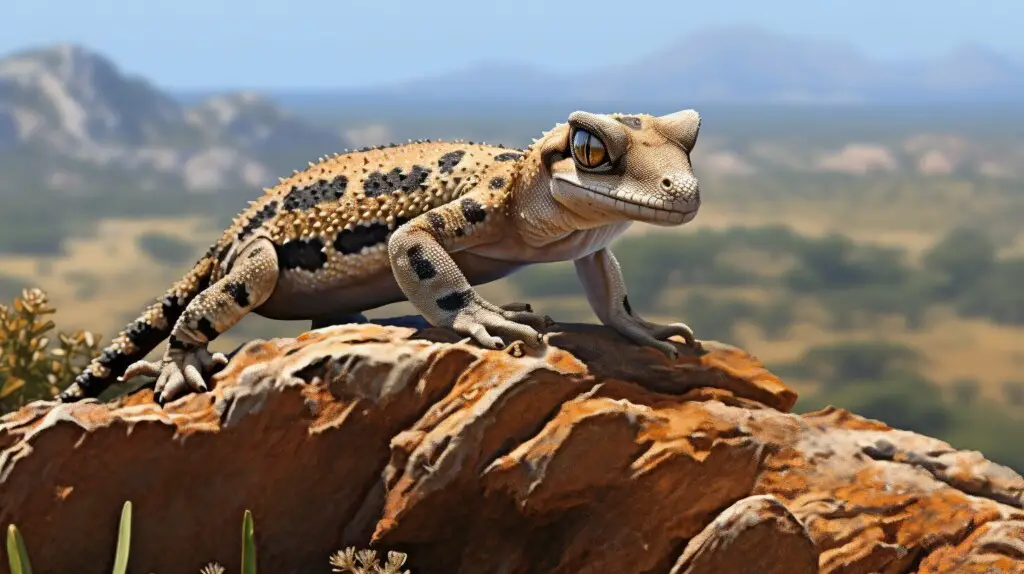
| Physical Characteristics | Details |
|---|---|
| Size | Around 8 inches in length |
| Coloration | Varying shades of brown, orange, and red |
| Body Type | Stocky with granular scales |
| Tail | Thick and fat-filled, used as an energy and water reserve |
| Head | Large with round, dark eyes |
| Regeneration Ability | Capable of regrowing lost or damaged tails |
Behavioral Traits of the African Fat-Tailed Gecko
The African Fat-Tailed Gecko is primarily nocturnal, preferring to hide and sleep in shelters during the day. Their secretive nature allows them to avoid predators and conserve energy, as they emerge at dusk to hunt for food.
These geckos are solitary creatures, rarely interacting with others of their kind except for mating purposes. They are known for their docile temperament, making them popular pets among reptile enthusiasts. Despite their laid-back demeanor, they can become defensive if they feel threatened.
One interesting aspect of the African Fat-Tailed Gecko’s behavior is its ability to vocalize. While not as vocal as some other reptiles, they can produce soft clicking or chirping sounds as a form of communication. These sounds are typically made during courtship or territorial disputes with other geckos.
As with many other gecko species, the African Fat-Tailed Gecko possesses the remarkable ability to regenerate its tail. When threatened or grabbed by a predator, it can detach its tail, which will then wriggle and distract the attacker while the gecko makes its escape. Over time, the gecko will regrow its tail, although it may not be an exact replica of the original.
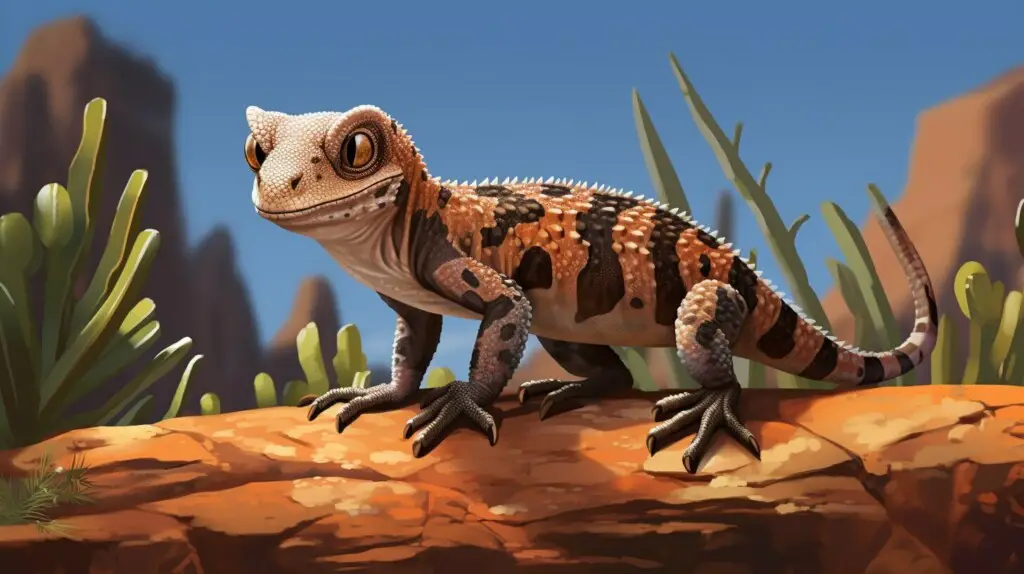
Reproduction and Breeding of the African Fat-Tailed Gecko
The breeding season for African Fat-Tailed Geckos lasts approximately 5 months, with females laying up to five clutches of eggs. During this time, the females will seek out suitable nesting sites in their habitat. They prefer warm and humid environments, often choosing areas with loose soil or sand to lay their eggs.
Once the female has selected a nesting site, she will dig a shallow hole and deposit her eggs. The number of eggs in each clutch can vary, but typically ranges from 1 to 2 eggs. The eggs are oval-shaped and have a soft, leathery shell.
After the female has laid her eggs, she will cover them with soil to protect them from predators and the elements. The incubation period for the eggs is around 60 to 80 days, depending on the temperature and humidity of the environment. During this time, it is crucial to maintain the proper conditions to ensure successful hatching.
Once the eggs hatch, the baby geckos, known as hatchlings, emerge from the nest and are independent from birth. They are miniature versions of the adults, although they may have slightly different patterns or colors. The hatchlings will begin feeding on small insects and gradually grow over time.
Development and Growth of the African Fat-Tailed Gecko
The growth rate of African Fat-Tailed Geckos is relatively slow compared to other gecko species. They reach sexual maturity at around 1 to 2 years of age, depending on various factors such as diet and overall health.
As the geckos grow, their pattern and coloration may change slightly. Males tend to have more vibrant and pronounced patterns, while females usually have a more subdued appearance. Additionally, males generally have larger heads and thicker tails compared to females.
Providing a proper diet, adequate space, and appropriate environmental conditions are crucial for the healthy development of these geckos. Regular monitoring of growth and weight, along with veterinary check-ups, can ensure their well-being throughout their lifespan.
| Key Points: | Details: |
|---|---|
| Reproductive Season | About 5 months |
| Number of Clutches | Up to 5 clutches of eggs |
| Egg Incubation Period | 60-80 days |
| Growth Rate | Slow, reaching sexual maturity at 1-2 years |
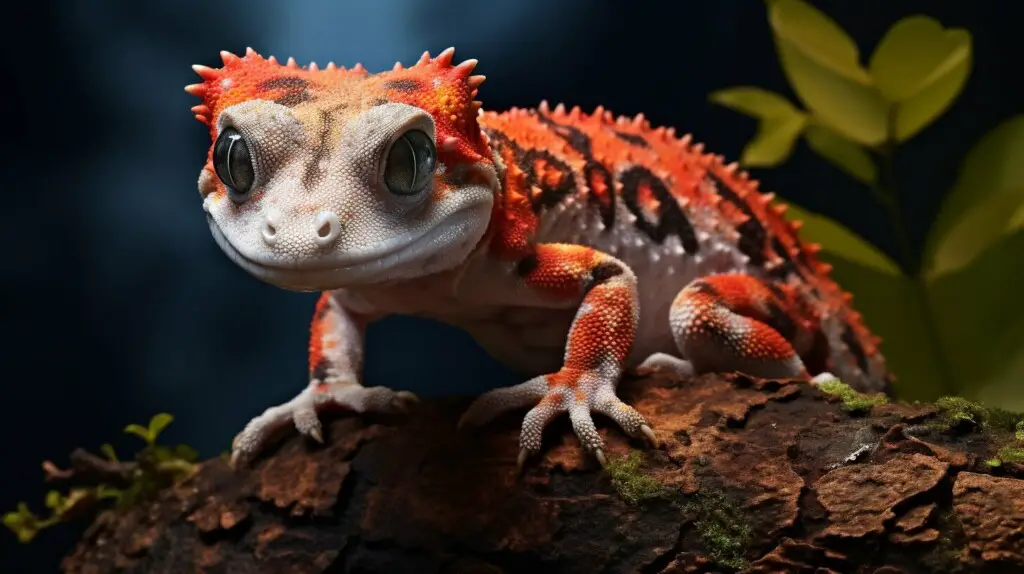
Sexual Dimorphism in the African Fat-Tailed Gecko
The African Fat-Tailed Gecko exhibits sexual dimorphism, with males being larger in size compared to females. This distinction in size can be seen in their overall body length and width. Adult males typically measure around 8-10 inches in length, while females are slightly smaller, ranging from 7-9 inches. This difference in size is believed to be related to reproductive strategies and competition for mates.
In addition to size, male African Fat-Tailed Geckos often have broader heads and thicker tails compared to their female counterparts. This physical variation is more pronounced during the breeding season when males display territorial behavior and engage in dominance contests. The larger size and more robust features of males serve as an advantage in attracting and securing a mate.
It is worth noting that while males are generally larger, both male and female African Fat-Tailed Geckos possess the same distinct pattern of light and dark blotches or bands across their back and tail. This unique patterning is not influenced by sexual dimorphism and is a characteristic trait observed in all individuals of this species.
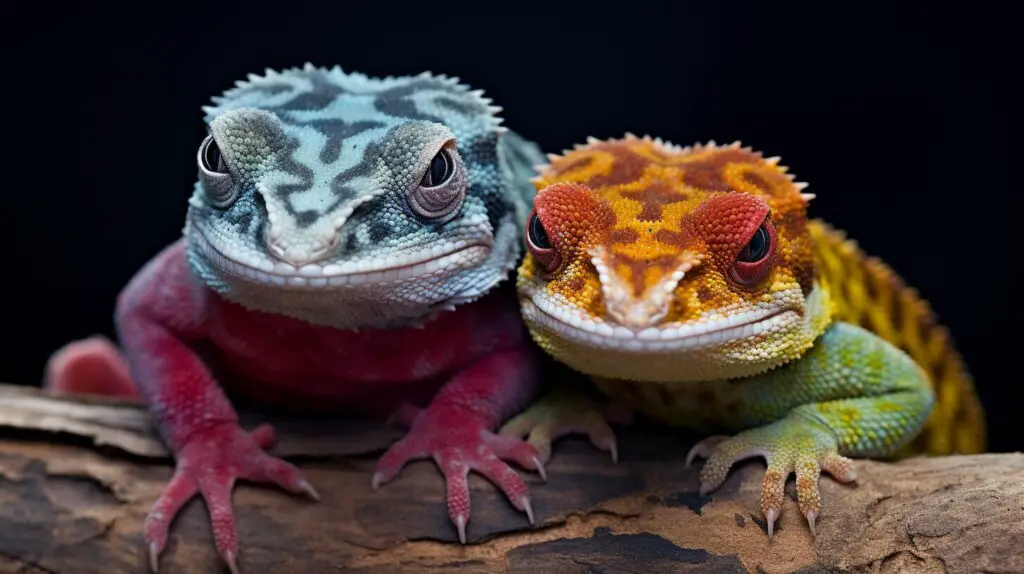
| Characteristic | Male | Female |
|---|---|---|
| Size (Length) | 8-10 inches | 7-9 inches |
| Head Shape | Broader | Slightly narrower |
| Tail Thickness | Thicker | Relatively thinner |
In summary, sexual dimorphism in the African Fat-Tailed Gecko is evident through the larger size and more robust features of males compared to females. This physical variation is believed to play a role in reproductive strategies and mate competition. Both male and female geckos, however, share the same distinct pattern of light and dark blotches across their back and tail, which is unrelated to sexual dimorphism.
Development and Growth of the African Fat-Tailed Gecko
After hatching, African Fat-Tailed Gecko hatchlings grow at similar rates until around 350 days, when males start to diverge from females in development. It is during this time that their sexual dimorphism becomes more pronounced. Males usually experience a growth spurt and begin to outgrow their female counterparts. This divergence is attributed to hormonal and genetic factors, leading to the distinct size difference between the sexes.
To ensure optimal growth and development, it is essential to provide the geckos with a suitable habitat. This includes maintaining appropriate temperatures and humidity levels, as well as offering a varied diet that meets their nutritional requirements. Providing a secure and spacious enclosure with hiding spots and climbing opportunities allows the geckos to exercise and explore, promoting their overall well-being.
Factors Affecting Growth
Several factors can influence the growth of African Fat-Tailed Geckos. Temperature plays a crucial role, as it directly affects their metabolic processes. The geckos require a temperature gradient within their enclosure, ranging from around 80°F to 90°F (27°C to 32°C) during the day, with a slight drop at night. This helps regulate their metabolism and ensures proper digestion. Failure to maintain appropriate temperatures can lead to stunted growth and other health issues.
Another key factor is nutrition. A balanced diet consisting of gut-loaded insects, such as crickets and mealworms, as well as occasional supplementation with calcium and vitamin D3, is essential for their growth and bone development. Proper hydration is also crucial, and providing a shallow water dish or misting the enclosure regularly helps ensure they stay hydrated.
| Factors Affecting Growth | Description |
|---|---|
| Temperature | Maintain a temperature gradient within the enclosure, ranging from around 80°F to 90°F (27°C to 32°C) during the day, with a slight drop at night. |
| Nutrition | Offer a balanced diet of gut-loaded insects, such as crickets and mealworms, along with occasional calcium and vitamin D3 supplementation. |
| Hydration | Ensure proper hydration by providing a shallow water dish or misting the enclosure regularly. |
It is important to monitor the growth of individual geckos and adjust their care accordingly. Regular weigh-ins and visual assessment can help identify any potential issues early on. Consulting with a reptile veterinarian specializing in geckos can also provide valuable guidance and ensure the geckos receive the best care possible.
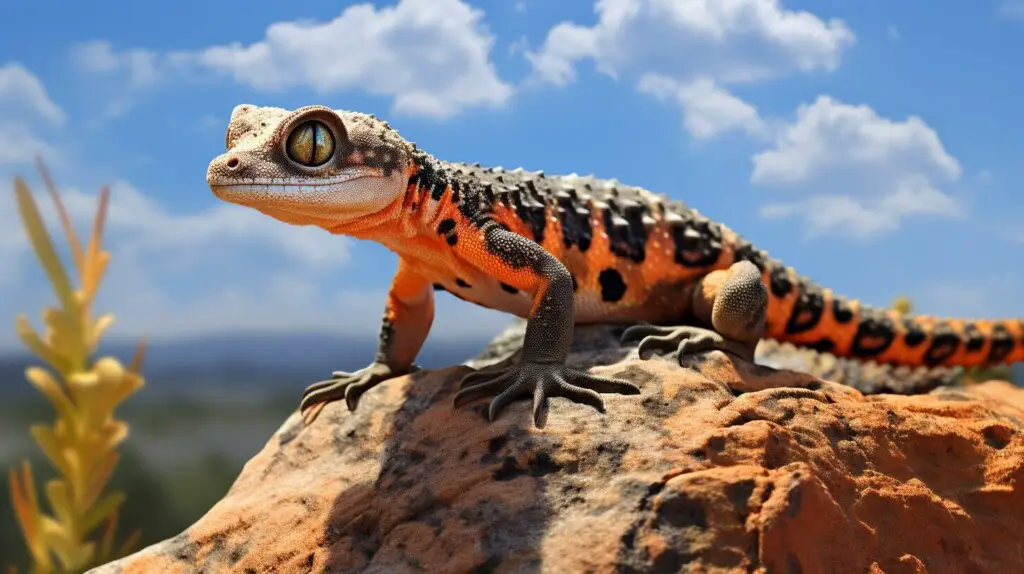
With proper care and attention to their growth and development needs, African Fat-Tailed Geckos can thrive and reach their full potential. Understanding the factors that influence their growth, such as temperature, nutrition, and hydration, is key to ensuring their overall well-being. By providing a suitable habitat and monitoring their progress, gecko enthusiasts can enjoy watching these fascinating creatures grow into healthy adults.
Conservation Status of the African Fat-Tailed Gecko
The African Fat-Tailed Gecko is currently listed as Least Concern because it is believed to be widespread and relatively common, with only localized threats. This species has a native range in West Africa, specifically from Senegal to northern Cameroon, where it inhabits dry and hot/tropical environments such as rocky woodlands and savannas. However, due to its popularity as a pet, African Fat-Tailed Geckos have been widely distributed throughout the world through captive breeding programs.
These geckos have adapted well to different climates and can be found in various countries, including the United States. Their popularity can be attributed to their unique physical appearance, with a stocky body and a distinct pattern of light and dark blotches or bands across their back and tail. They typically grow to around 8 inches in length, making them a manageable size for many reptile enthusiasts.

As ectothermic creatures, African Fat-Tailed Geckos rely on their environment to regulate their body temperature. They require moderate temperatures and humidity levels to thrive. In the wild, these geckos are nocturnal, preferring to hide and sleep in shelters during the day. Their behavior changes when kept in captivity, as they can adapt to a diurnal routine if provided with proper lighting and environmental conditions.
One interesting aspect of African Fat-Tailed Geckos is their sexual dimorphism, where males are larger than females. They have a breeding season of around 5 months, during which females can lay up to five clutches of eggs. The geckos display temperature-dependent sex determination, meaning that lower temperatures result in female offspring, while higher temperatures result in male offspring. The hatchlings grow at similar rates until around 350 days after hatching, at which point males begin to diverge from females in development.
Table: Conservation Status of the African Fat-Tailed Gecko
| Conservation Status | Threats |
|---|---|
| Least Concern | Localized threats |
Despite being widespread and relatively common, it is important to note that localized threats to the African Fat-Tailed Gecko do exist. Habitat loss, mainly due to deforestation and urbanization, poses a significant risk to their populations in certain regions. Additionally, the illegal pet trade may contribute to localized declines if unsustainable collection practices are employed.
Overall, the African Fat-Tailed Gecko’s conservation status is currently considered to be of least concern, thanks to both their native populations in West Africa and the successful captive breeding programs that have allowed them to flourish across the globe. However, it is crucial to prioritize responsible pet ownership and conservation efforts to ensure the long-term sustainability of this fascinating reptile species.
Captive Breeding and Global Distribution
Despite its native range being limited to West Africa, the African Fat-Tailed Gecko has become widely distributed throughout the world as a popular captive-bred pet. This gecko species has gained significant popularity among reptile enthusiasts due to its unique appearance, manageable size, and relatively easy care requirements. As a result, breeders and hobbyists have successfully established breeding programs, resulting in the availability of captive-bred geckos in many countries.
The global distribution of the African Fat-Tailed Gecko has significantly expanded due to the captive breeding efforts. These geckos are now found in various parts of North America, Europe, Asia, and Australia. Their adaptability to different climates and the relatively low maintenance they require make them a favored choice for reptile keepers around the world.
One of the key factors contributing to the successful captive breeding and widespread distribution of African Fat-Tailed Geckos is their ability to thrive in captivity. They have proven to be resilient and adaptable, adjusting well to artificial environments when provided with appropriate husbandry conditions. This has allowed breeders to establish stable populations and offer these geckos to reptile enthusiasts worldwide.
The Importance of Temperature and Climate
Creating a suitable environment for African Fat-Tailed Geckos is crucial for their well-being and reproductive success. These geckos require moderate temperatures ranging from 75°F to 85°F (24°C to 29°C) during the day and a slight drop to around 70°F (21°C) at night. Proper temperature regulation is essential for their metabolic functions, digestion, and overall health.
In addition to temperature, humidity plays a vital role in maintaining optimal conditions for the African Fat-Tailed Gecko. A humidity level of 50% to 60% is recommended to ensure proper shedding and prevent dehydration. Providing hiding spots and shelters within their enclosure helps create microclimates and allows the geckos to regulate their temperature and moisture levels according to their needs.
In conclusion, the African Fat-Tailed Gecko’s distribution has been significantly expanded worldwide through captive breeding programs. These geckos have become beloved pets in many countries, thanks to their unique characteristics and the efforts of dedicated breeders. The successful establishment of captive-bred populations highlights the adaptability and resilience of this species. By recreating their natural habitat and ensuring appropriate temperature and humidity levels, reptile enthusiasts can provide optimal conditions for the well-being and thriving of these captivating geckos.

| Country | Region | Availability |
|---|---|---|
| United States | North America | Widely available |
| United Kingdom | Europe | Widely available |
| Australia | Oceania | Widely available |
| Germany | Europe | Widely available |
| Canada | North America | Widely available |
Importance of Temperature and Climate for African Fat-Tailed Geckos
African Fat-Tailed Geckos are ectothermic reptiles and require moderate temperatures and humidity to thrive. These geckos are native to West Africa, specifically ranging from Senegal to northern Cameroon, where they have adapted to dry and hot/tropical climates. In their natural habitat, they are commonly found in rocky woodlands and savannas.
When caring for African Fat-Tailed Geckos in captivity, it is crucial to recreate their native climate as closely as possible. Maintaining the proper temperature and humidity levels is essential for their overall health and well-being.
To ensure the optimal temperature range for African Fat-Tailed Geckos, a temperature gradient should be provided within their enclosure. This can be achieved by using a heat source, such as an under-tank heater or a heat mat, on one side of the enclosure. The temperature on the warm side should be around 88-92°F (31-33°C), while the cool side should be slightly cooler, around 78-82°F (25-28°C). This temperature gradient allows the geckos to regulate their body temperature by moving between different temperature zones.
In addition to temperature, humidity levels should be carefully maintained. African Fat-Tailed Geckos require moderate humidity levels of around 40-60%. This can be achieved by misting the enclosure with water daily and providing a shallow water dish for the geckos to drink from and soak in if desired.
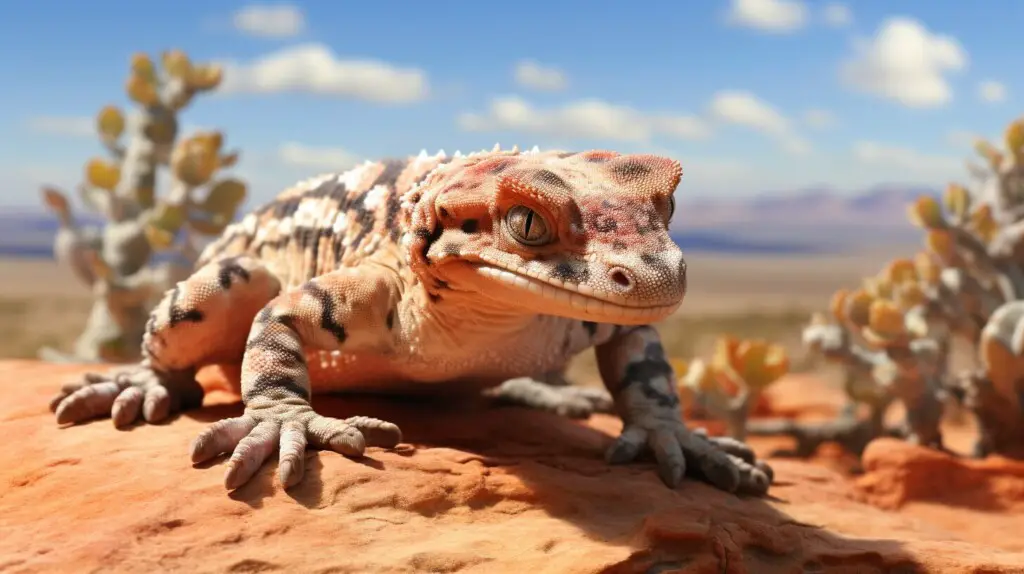
| Parameter | Ideal Range |
|---|---|
| Temperature | Warm side: 88-92°F (31-33°C) Cool side: 78-82°F (25-28°C) |
| Humidity | 40-60% |
Maintaining the proper temperature and humidity levels is crucial for the overall health and well-being of African Fat-Tailed Geckos. Failure to provide the appropriate climate conditions can lead to stress, improper digestion, respiratory issues, and other health problems. It is important to regularly monitor the temperature and humidity levels within the gecko’s enclosure to ensure they are within the recommended ranges.
By carefully monitoring and adjusting the temperature and humidity levels in the enclosure, you can create a comfortable and suitable environment for your African Fat-Tailed Geckos. Providing them with the proper climate conditions will help promote their overall health, activity, and reproductive success.
Summary:
- African Fat-Tailed Geckos are ectothermic reptiles and require moderate temperatures and humidity to thrive.
- Their native habitat consists of dry and hot/tropical climates, specifically rocky woodlands and savannas in West Africa.
- Maintaining the correct temperature and humidity levels within the gecko’s enclosure is essential for their overall health and well-being.
- Recommended temperature ranges include 88-92°F (31-33°C) on the warm side and 78-82°F (25-28°C) on the cool side.
- Moderate humidity levels of around 40-60% should be maintained through regular misting and the provision of a shallow water dish.
Failure to provide the appropriate climate conditions can lead to stress, improper digestion, respiratory issues, and other health problems. Regular monitoring and adjustment of temperature and humidity levels are necessary to ensure the well-being of African Fat-Tailed Geckos in captivity.
Conclusion
In conclusion, the African Fat-Tailed Gecko is native to specific regions of West Africa but has a global presence as a popular captive-bred pet. These geckos can be found in the dry and hot/tropical climates of West Africa, specifically ranging from Senegal to northern Cameroon. They are well adapted to rocky woodlands and savannas, making these habitats their natural homes.
Although their native range may be limited, African Fat-Tailed Geckos have gained popularity as pets worldwide. Thanks to captive breeding programs, these geckos can now be found in homes across the globe. Their distinctive physical characteristics, such as a stocky body and a pattern of light and dark blotches or bands, make them a visually appealing choice for reptile enthusiasts.
When it comes to their survival, African Fat-Tailed Geckos are ectothermic creatures, meaning they rely on external sources of heat to regulate their body temperature. They require moderate temperatures and humidity to thrive. These geckos are nocturnal by nature, preferring to hide and sleep in shelters during the day and becoming active at night to search for food.
Sexual dimorphism is also observed in African Fat-Tailed Geckos, with males being larger than females. During the breeding season, which typically lasts around 5 months, females can lay up to five clutches of eggs. Interestingly, the sex of the offspring is determined by the temperature at which the eggs are incubated. Lower temperatures generally result in female hatchlings, while higher temperatures lead to male hatchlings.
In terms of conservation status, the African Fat-Tailed Gecko is listed as Least Concern. Despite localized threats, they are considered to be widespread and common. This is attributed to their adaptability and the success of captive breeding programs, which have contributed to their global distribution and popularity as pets.
FAQ
Where is the African Fat-Tailed Gecko found in the World?
The African Fat-Tailed Gecko is native to West Africa, specifically ranging from Senegal to northern Cameroon. However, they are widely distributed throughout the world as captive-bred pets.
What is the habitat of the African Fat-Tailed Gecko?
The African Fat-Tailed Gecko inhabits dry and hot/tropical climates and is adapted for rocky woodlands and savannas.
How does the African Fat-Tailed Gecko look physically?
The African Fat-Tailed Gecko has a stocky body, growing to around 8 inches in length. They have a distinct pattern of light and dark blotches or bands across their back and tail.
What are the behavioral traits of the African Fat-Tailed Gecko?
The African Fat-Tailed Gecko is nocturnal and tends to hide and sleep in shelters during the day.
How does the African Fat-Tailed Gecko reproduce and breed?
The African Fat-Tailed Gecko has a breeding season of around 5 months, with females laying up to five clutches of eggs.
Is there sexual dimorphism in the African Fat-Tailed Gecko?
Yes, there is sexual dimorphism in the African Fat-Tailed Gecko, with males being larger than females.
How does the African Fat-Tailed Gecko develop and grow?
The hatchlings grow at similar rates until around 350 days after hatching, when males begin to diverge from females in development.
What is the conservation status of the African Fat-Tailed Gecko?
The African Fat-Tailed Gecko is listed as Least Concern as they are widespread and thought to be common with only localized threats.
How did the African Fat-Tailed Gecko become globally distributed?
The African Fat-Tailed Gecko is widely distributed throughout the world as a result of captive breeding for the pet trade.
Why is temperature and climate important for African Fat-Tailed Geckos?
African Fat-Tailed Geckos require moderate temperatures and humidity to survive and thrive. Temperature and climate play a crucial role in their well-being.
